Posted by Brent Modzelewski on April 1, 2020
What is a Biodynamic Wine?
Holy Cow, that's no Bull
Biodynamic is one of the biggest buzzwords in the wine industry lately.
So what does Biodynamic mean to me as a consumer of wine? In a nutshell (or cow's horn in biodynamic terms) is organic farming…with a "spiritual" twist.
By spiritual, it means it is influenced by astrological and lunar cycles, along with rituals.
Aside from the hocus pocus, Biodynamic and Organic farming practices are to bring high-quality grapes without synthetic pesticides, without synthetic herbicides and without genetically modified organisms (kind of sort of, see Nerd Fact below).
So basically, it is better for you without the chemicals.
The practice of Biodynamic farming is to treat the entire vineyard as a single living thing, rather than just farming the grapes themselves.
Biodynamic farmers strive to be regenerative and sustainable.
Biodynamic farming goes a bit further than organic farming by the integration of livestock and other animals onto the vineyard to help feed on weeds and create fertilizer naturally for the soil.
Rudolf Steiner is the founder of Biodynamic Farming in 1924, valued the philosophy of the lunar calendar as part of the ebbs and flows of nature in this type of farming.
This is not dissimilar to the Farmer's Almanac used in traditional farming.
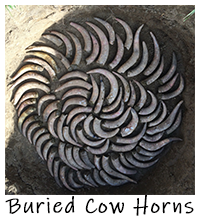 So of the oddities of Biodynamic farming include filling a cow horn (not a bull's horn must be a cow’s horn) with manure and burying on the property for 6 months.
The horn is then dug up and mixed with water for 1 hour, then sprayed on the property for fertilizer.
This spiritual ritual, created by Steiner, is called, Process 500 and is one of nine of the compost preparations.
The number of cow horns planted is dependent on the size of the property.
Probably makes for good nutrient-rich fertilizer, but I call bullshit on the whole cow horn nonsense.
Without getting into too much detail, the nine preparations are labeled 500-508 and include horn manure, horn silica, yarrow, chamomile, stinging needle, oak bark, dandelion, valerian, and horsetail tea.
So of the oddities of Biodynamic farming include filling a cow horn (not a bull's horn must be a cow’s horn) with manure and burying on the property for 6 months.
The horn is then dug up and mixed with water for 1 hour, then sprayed on the property for fertilizer.
This spiritual ritual, created by Steiner, is called, Process 500 and is one of nine of the compost preparations.
The number of cow horns planted is dependent on the size of the property.
Probably makes for good nutrient-rich fertilizer, but I call bullshit on the whole cow horn nonsense.
Without getting into too much detail, the nine preparations are labeled 500-508 and include horn manure, horn silica, yarrow, chamomile, stinging needle, oak bark, dandelion, valerian, and horsetail tea.
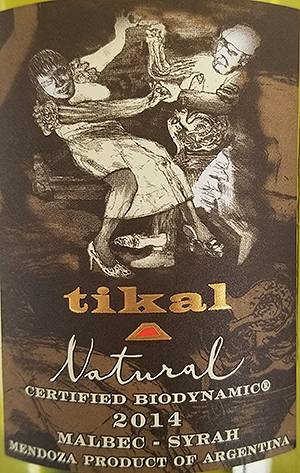 Biodynamic and bio-dynamic are not quite the same. Biodynamic is a registered trademark and wine bottles with this trademark mean they are biodynamic certified through Demeter.
Biodynamic and bio-dynamic are not quite the same. Biodynamic is a registered trademark and wine bottles with this trademark mean they are biodynamic certified through Demeter.
This bottle of Tikal from Ernesto Catena Vineyards boasts the Biodynamic registered trademark on the front label and the Demeter biodynamic logo on the rear label.
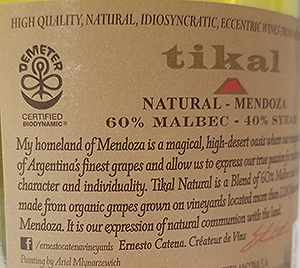
Look for the following logos when purchasing Biodynamic or Organic wines in the United States or in Europe.
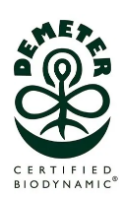
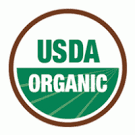

 So of the oddities of Biodynamic farming include filling a cow horn (not a bull's horn must be a cow’s horn) with manure and burying on the property for 6 months.
The horn is then dug up and mixed with water for 1 hour, then sprayed on the property for fertilizer.
This spiritual ritual, created by Steiner, is called, Process 500 and is one of nine of the compost preparations.
The number of cow horns planted is dependent on the size of the property.
Probably makes for good nutrient-rich fertilizer, but I call bullshit on the whole cow horn nonsense.
Without getting into too much detail, the nine preparations are labeled 500-508 and include horn manure, horn silica, yarrow, chamomile, stinging needle, oak bark, dandelion, valerian, and horsetail tea.
So of the oddities of Biodynamic farming include filling a cow horn (not a bull's horn must be a cow’s horn) with manure and burying on the property for 6 months.
The horn is then dug up and mixed with water for 1 hour, then sprayed on the property for fertilizer.
This spiritual ritual, created by Steiner, is called, Process 500 and is one of nine of the compost preparations.
The number of cow horns planted is dependent on the size of the property.
Probably makes for good nutrient-rich fertilizer, but I call bullshit on the whole cow horn nonsense.
Without getting into too much detail, the nine preparations are labeled 500-508 and include horn manure, horn silica, yarrow, chamomile, stinging needle, oak bark, dandelion, valerian, and horsetail tea.
 Biodynamic and bio-dynamic are not quite the same. Biodynamic is a registered trademark and wine bottles with this trademark mean they are biodynamic certified through Demeter.
Biodynamic and bio-dynamic are not quite the same. Biodynamic is a registered trademark and wine bottles with this trademark mean they are biodynamic certified through Demeter.
This bottle of Tikal from Ernesto Catena Vineyards boasts the Biodynamic registered trademark on the front label and the Demeter biodynamic logo on the rear label.

Look for the following logos when purchasing Biodynamic or Organic wines in the United States or in Europe.



Wine Nerd Fact Information
Genetically modified organisms… GMO.
Technically, most, if not all, wines are GMO.
Here is the rub… organic wines are GMO too. Wait…what? Why?
Well, first a little background on the grapevine itself, or more specifically, the root of the grapevine.
Phylloxera, a microscopic bug, which attacks the roots of grapevines nearly destroyed the entire world's grapevines in the 1860s.
To combat this pest, nearly all grapevines today are grafted to American rootstock that is resistant to this pest.
Studies at Max Planck Institute of Molecular Plant Physiology and Rutgers University have proven grafting allows the transfer of all three types of genomes and the cell swap mitochondria, in essence potentially creating a new species.
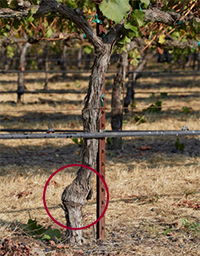 Next time you are at a vineyard, look for a knot near the base of the vine, that is where it was grafted.
To ease some fears of GMOs, grafting does occur in nature without human intervention.
Branches from different plants can come in contact with each other and graft together naturally.
I am a big opponent of GMOs, but I can make an exception for grafting, and only sound mildly contradictory.
Next time you are at a vineyard, look for a knot near the base of the vine, that is where it was grafted.
To ease some fears of GMOs, grafting does occur in nature without human intervention.
Branches from different plants can come in contact with each other and graft together naturally.
I am a big opponent of GMOs, but I can make an exception for grafting, and only sound mildly contradictory.
 Next time you are at a vineyard, look for a knot near the base of the vine, that is where it was grafted.
To ease some fears of GMOs, grafting does occur in nature without human intervention.
Branches from different plants can come in contact with each other and graft together naturally.
I am a big opponent of GMOs, but I can make an exception for grafting, and only sound mildly contradictory.
Next time you are at a vineyard, look for a knot near the base of the vine, that is where it was grafted.
To ease some fears of GMOs, grafting does occur in nature without human intervention.
Branches from different plants can come in contact with each other and graft together naturally.
I am a big opponent of GMOs, but I can make an exception for grafting, and only sound mildly contradictory.
Copyright Great Meadow Products, LLC. All rights reserved.
